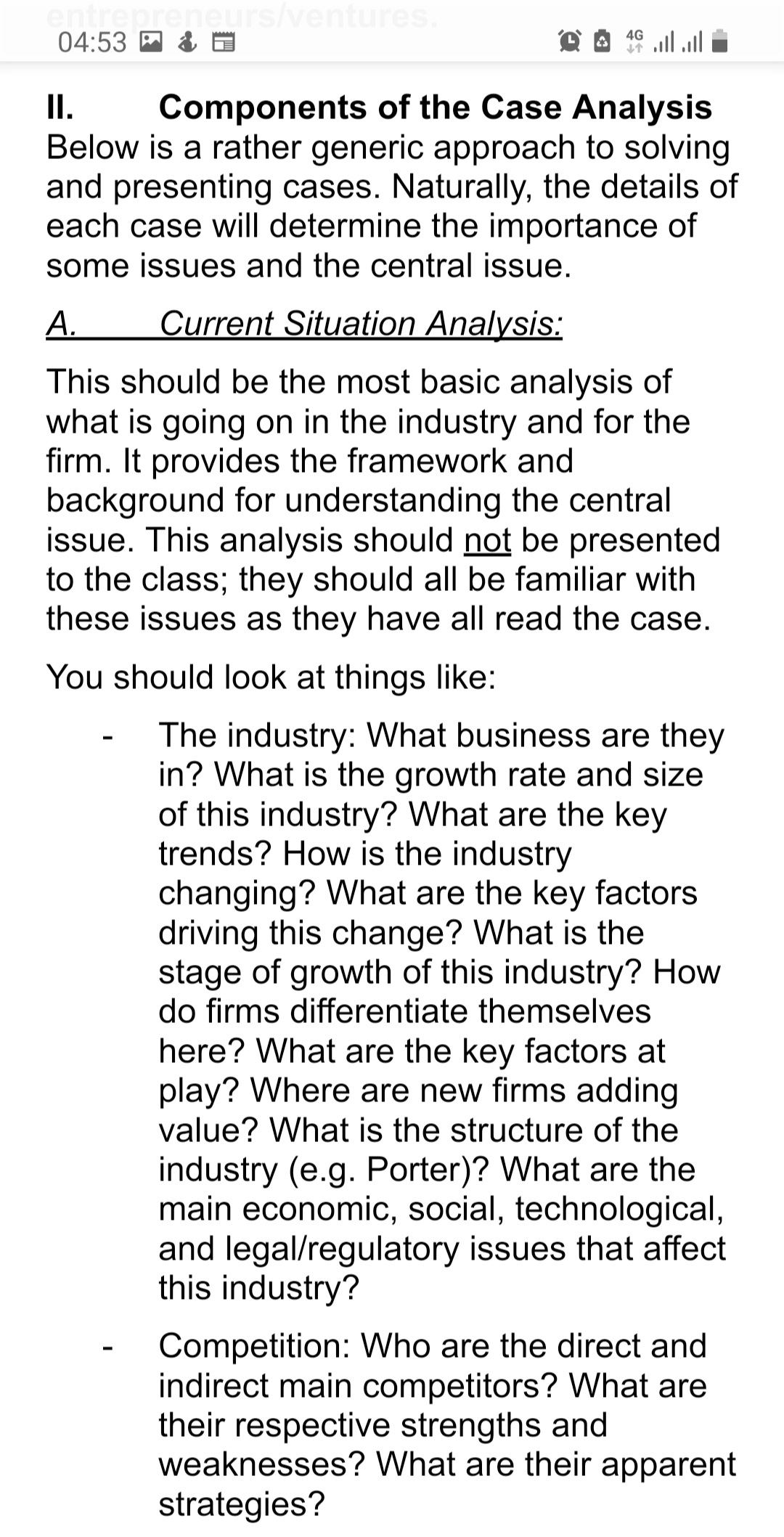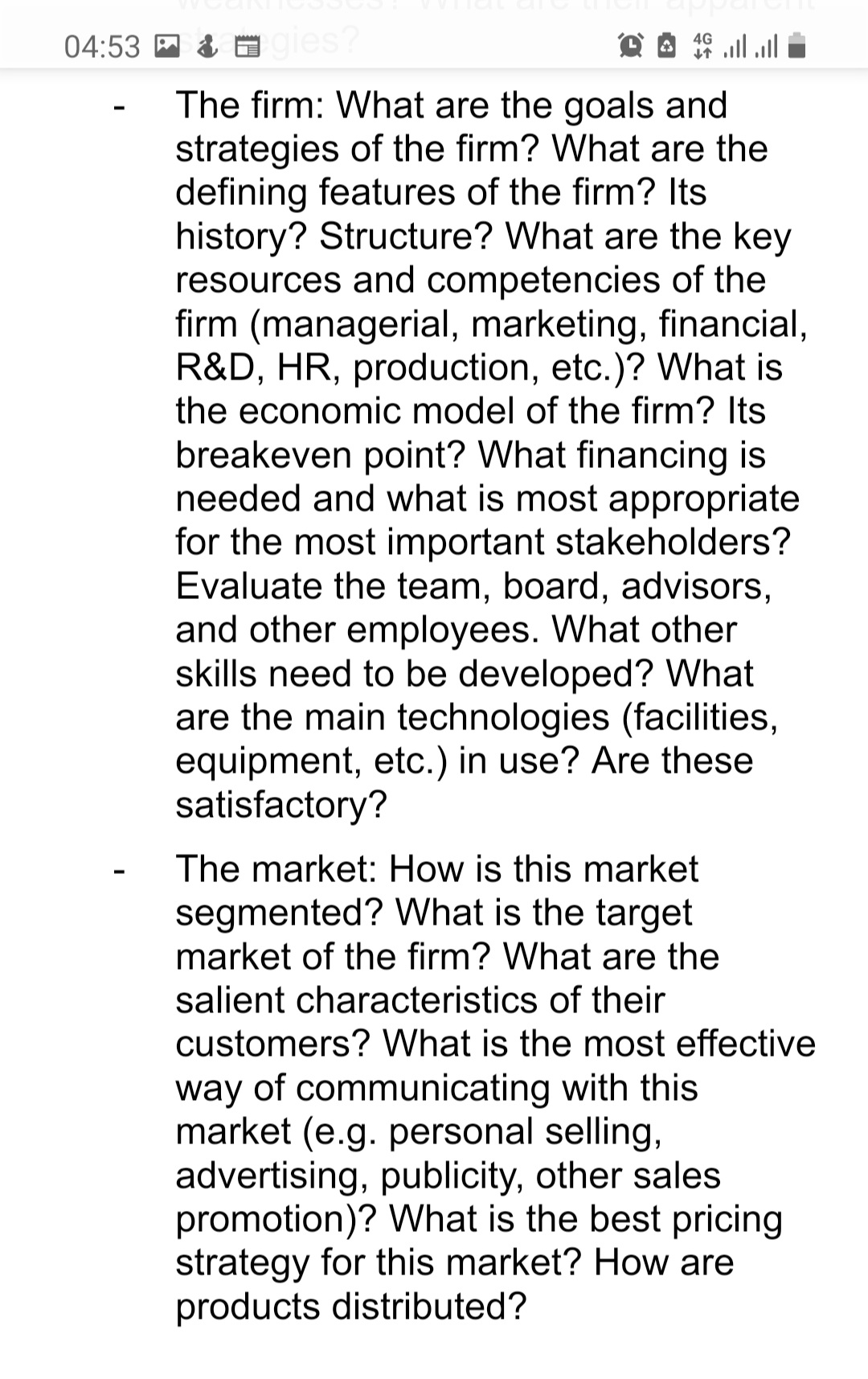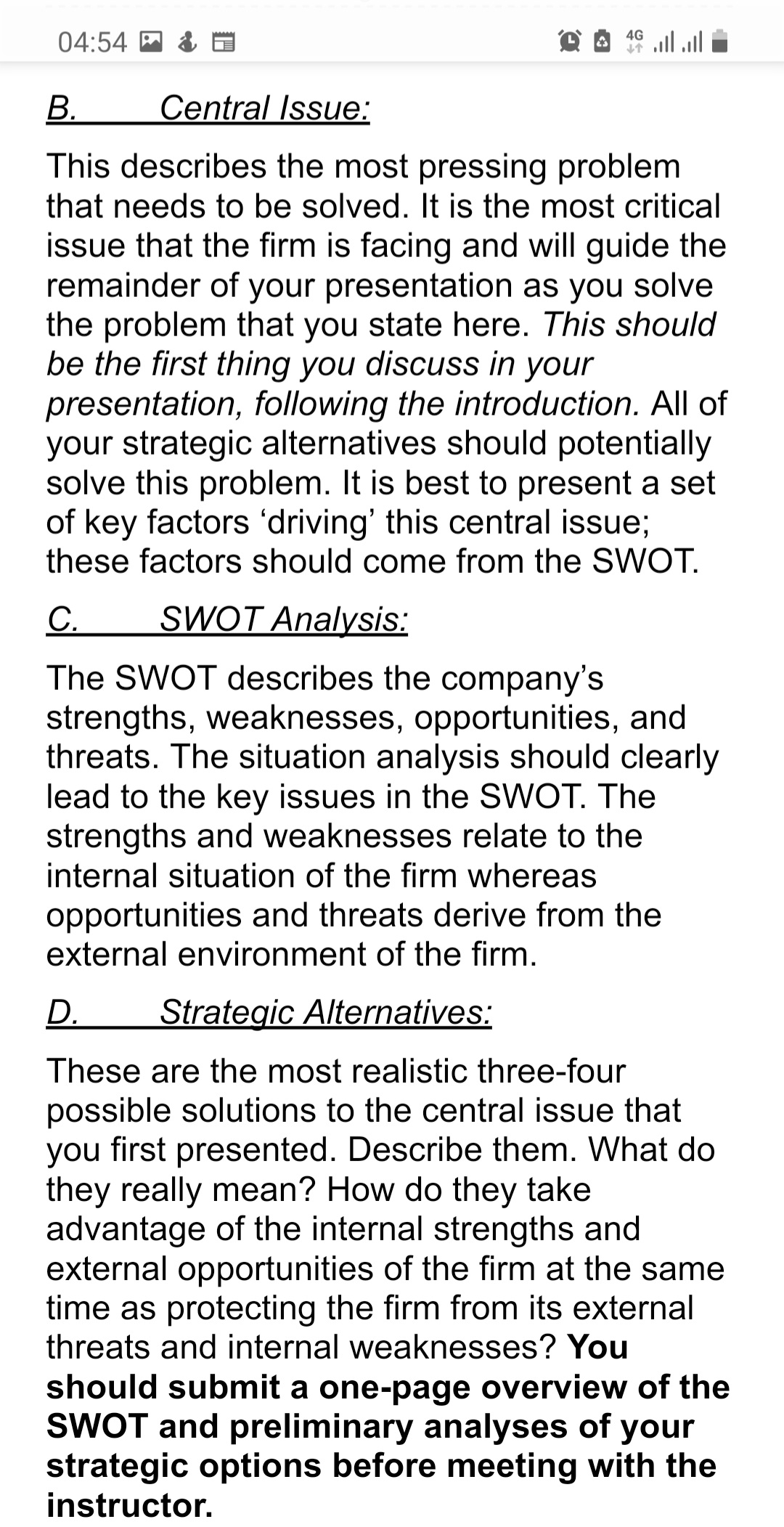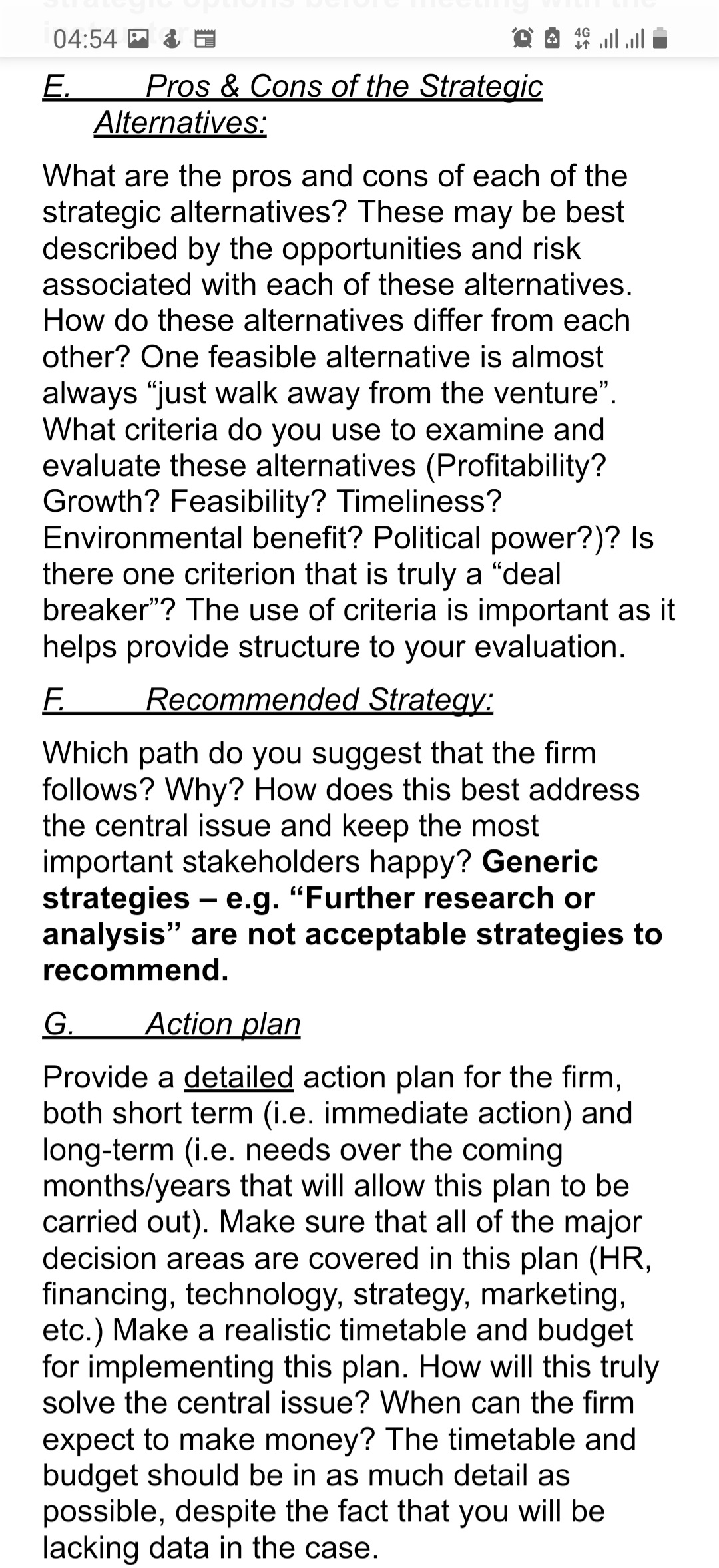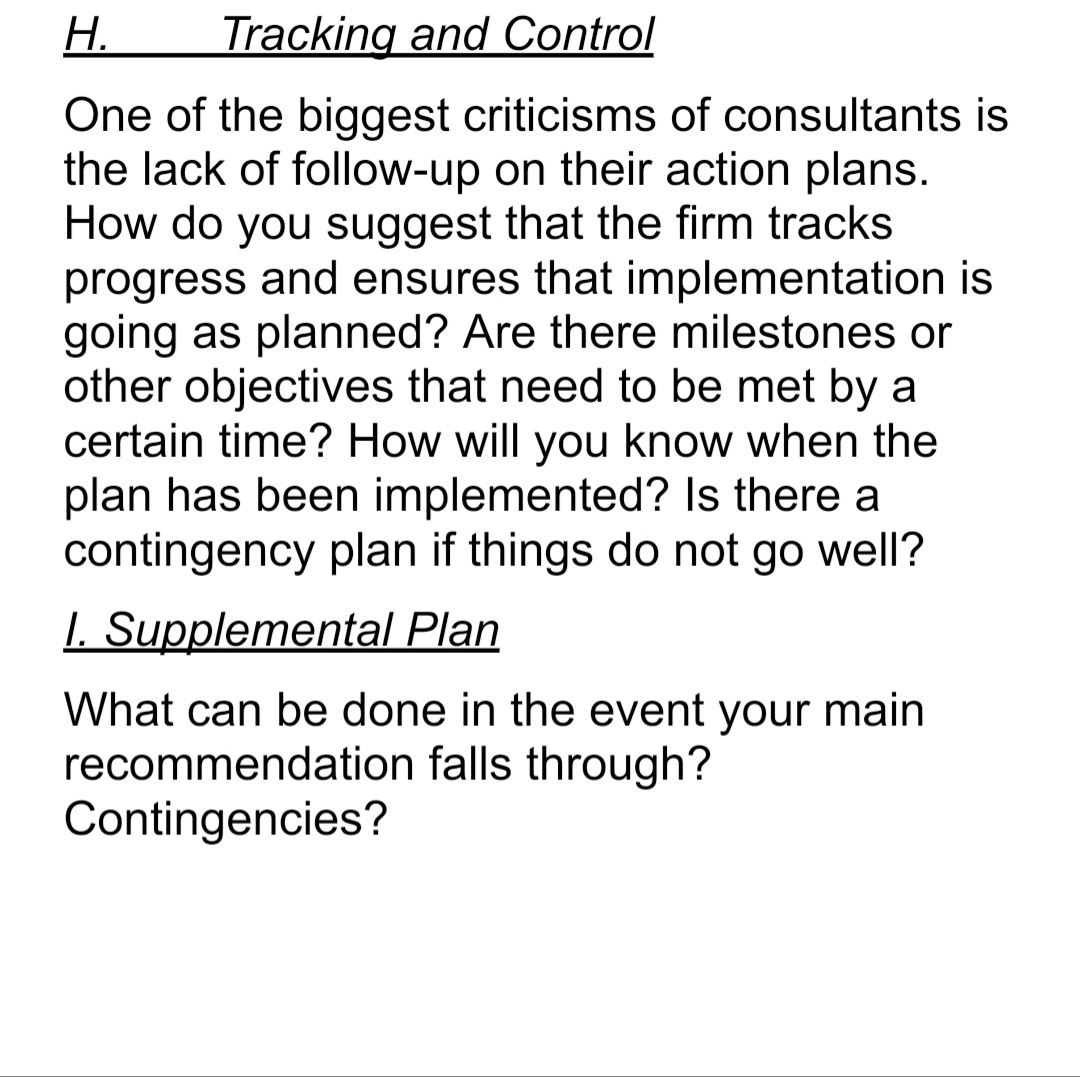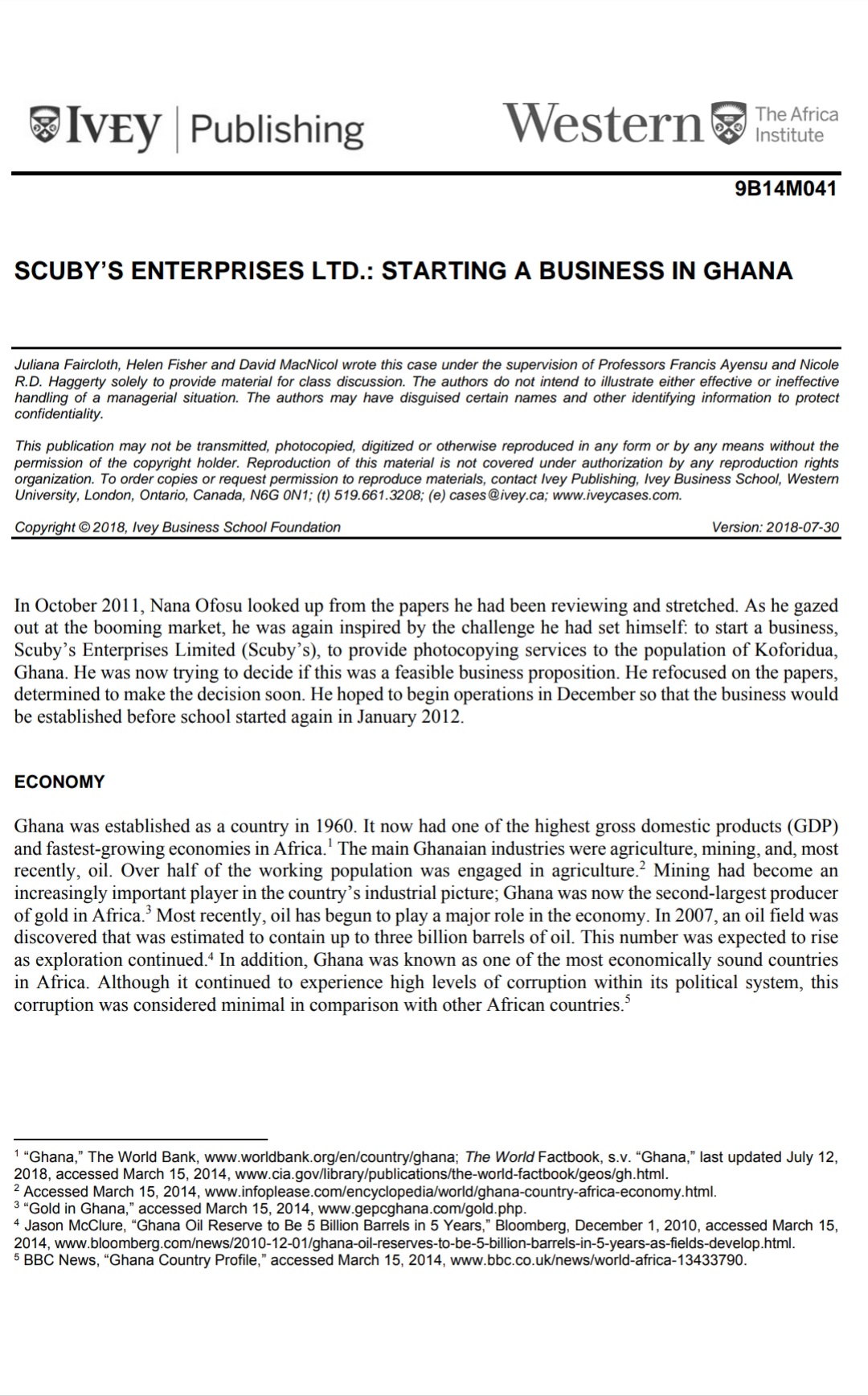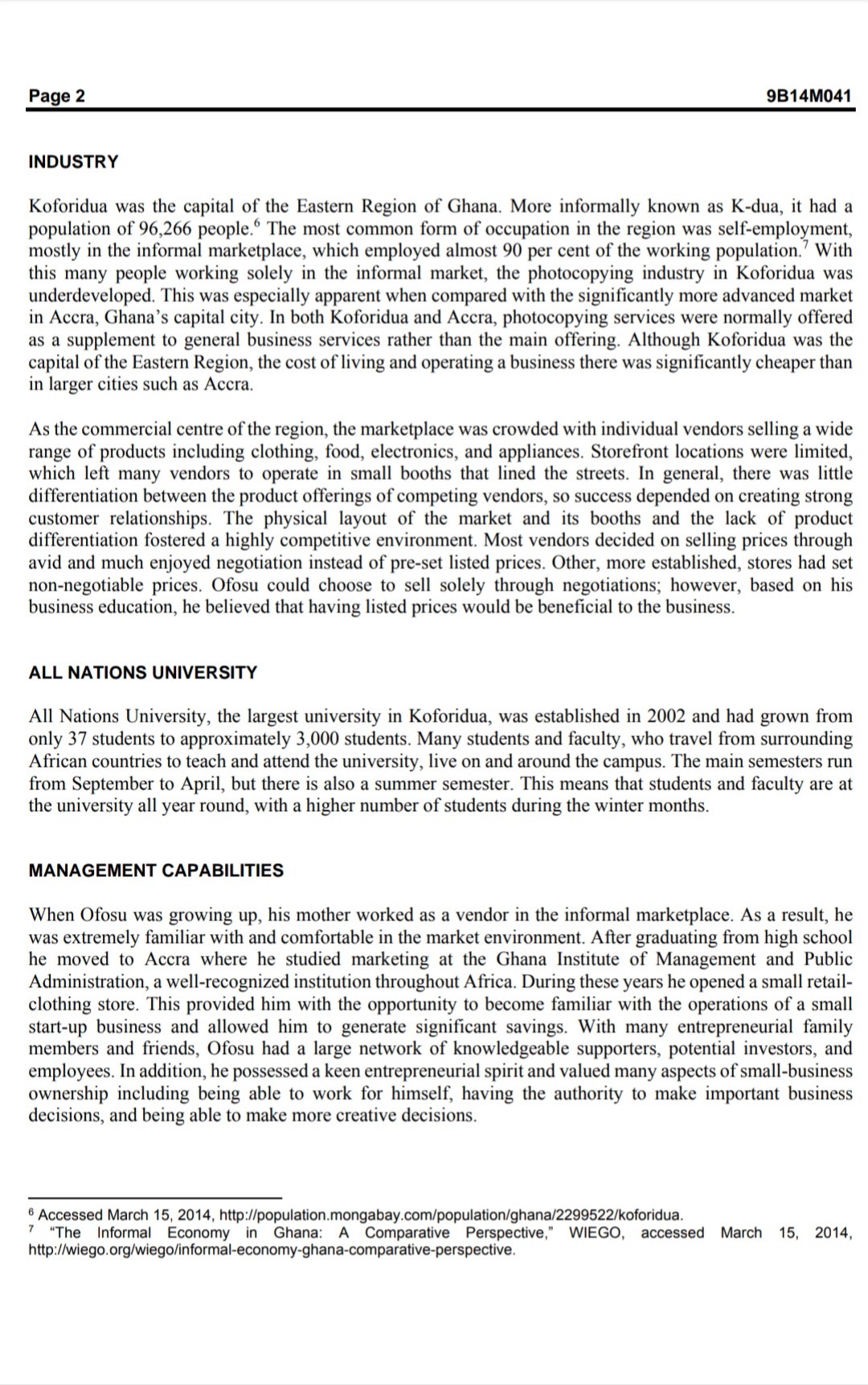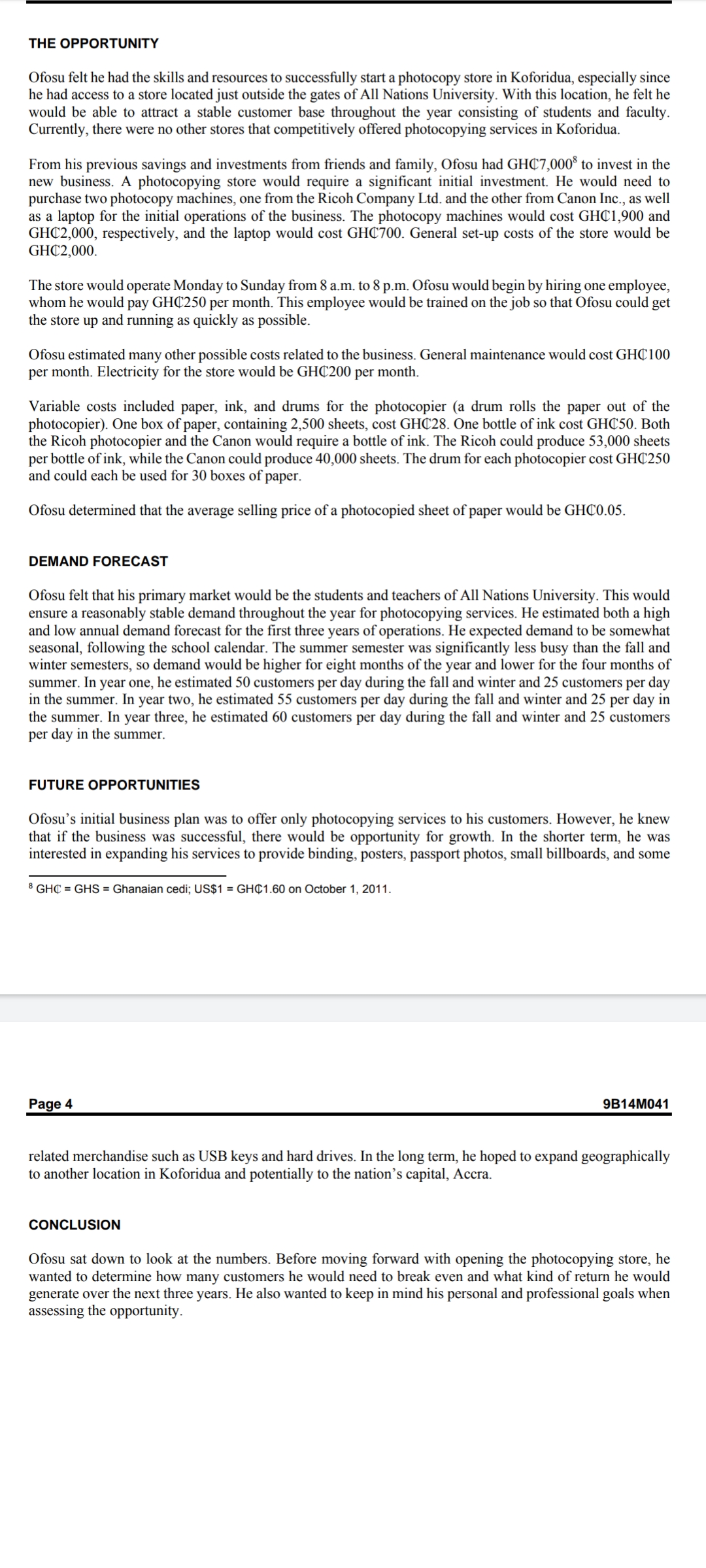Can you please help me with this assignment (preforming a case analysis for the case study below page 1-4, the instruction is also provided ). Please note that you should solve the case at the time the case was written.
04153 l2 4 E 9' 1% .III .III a ll. Components of the Case Analysis Below is a rather generic approach to solving and presenting cases. Naturally, the details of each case will determine the importance of some issues and the central issue. A. Current Situation Analysis: This should be the most basic analysis of what is going on in the industry and for the firm. It provides the framework and background for understanding the central issue. This analysis should n_ot be presented to the class; they should all be familiar with these issues as they have all read the case. You should look at things like: - The industry: What business are they in? What is the growth rate and size of this industry? What are the key trends? How is the industry changing? What are the key factors driving this change? What is the stage of growth of this industry? How do firms differentiate themselves here? What are the key factors at play? Where are new firms adding value? What is the structure of the industry (e.g. Porter)? What are the main economic, social, technological, and legal/regulatory issues that affect this industry? - Competition: Who are the direct and indirect main competitors? What are their respective strengths and weaknesses? What are their apparent strategies? 04:53 ID a, a '9' a 12 .I||.I|| i - The firm: What are the goals and strategies of the firm? What are the defining features of the firm? Its history? Structure? What are the key resources and competencies of the firm (managerial, marketing, financial, R&D, HR, production, etc.)? What is the economic model of the firm? Its breakeven point? What financing is needed and what is most appropriate for the most important stakeholders? Evaluate the team, board, advisors, and other employees. What other skills need to be developed? What are the main technologies (facilities, equipment, etc.) in use? Are these satisfactory? - The market: How is this market segmented? What is the target market of the firm? What are the salient characteristics of their customers? What is the most effective way of communicating with this market (e.g. personal selling, advertising, publicity, other sales promotion)? What is the best pricing strategy for this market? How are products distributed? 04:54 Ii 5 a 'G a 1? .III.|I| i B. Central Issue: This describes the most pressing problem that needs to be solved. It is the most critical issue that the firm is facing and will guide the remainder of your presentation as you solve the problem that you state here. This should be the rst thing you discuss in your presentation, following the introduction. All of your strategic alternatives should potentially solve this problem. It is best to present a set of key factors 'driving' this central issue; these factors should come from the SWOT. C. SWOT Analysis: The SWOT describes the company's strengths, weaknesses, Opportunities, and threats. The situation analysis should clearly lead to the key issues in the SWOT. The strengths and weaknesses relate to the internal situation of the firm whereas opportunities and threats derive from the external environment of the firm. D. Strategic Alternatives: These are the most realistic three-four possible solutions to the central issue that you first presented. Describe them. What do they really mean? How do they take advantage of the internal strengths and external opportunities of the firm at the same time as protecting the firm from its external threats and internal weaknesses? You should submit a one-page overview of the SWOT and preliminary analyses of your strategic options before meeting with the instructor. 04254 Ii 3 a Q 1? .III .III E E. Pros & Cons of the Strategic Alternatives: What are the pros and cons of each of the strategic alternatives? These may be best described by the opportunities and risk associated with each of these alternatives. How do these alternatives differ from each other? One feasible alternative is almost always \"just walk away from the venture\". What criteria do you use to examine and evaluate these alternatives (Profitability? Growth? Feasibility? Timeliness? Environmental benefit? Political power?)? Is there one criterion that is truly a \"deal breaker\"? The use of criteria is important as it helps provide structure to your evaluation. F. Recommended Strategy: Which path do you suggest that the firm follows? Why? How does this best address the central issue and keep the most important stakeholders happy? Generic strategies e.g. \"Further research or analysis\" are not acceptable strategies to recommend. G. Action plan Provide a detailed action plan for the firm, both short term (i.e. immediate action) and long-term (i.e. needs over the coming months/years that will allow this plan to be carried out). Make sure that all of the major decision areas are covered in this plan (HR, financing, technology, strategy, marketing, etc.) Make a realistic timetable and budget for implementing this plan. How will this truly solve the central issue? When can the firm expect to make money? The timetable and budget should be in as much detail as possible, despite the fact that you will be lacking data in the case. H. Tracking and Control One of the biggest criticisms of consultants is the lack of follow-up on their action plans. How do you suggest that the firm tracks progress and ensures that implementation is going as planned? Are there milestones or other objectives that need to be met by a certain time? How will you know when the plan has been implemented? Is there a contingency plan if things do not go well? I. Supplemental Plan What can be done in the event your main recommendation falls through? Contingencies? IVEy | Publishing Western The Africa Institute 9B14M041 SCUBY'S ENTERPRISES LTD.: STARTING A BUSINESS IN GHANA Juliana Faircloth, Helen Fisher and David MacNicol wrote this case under the supervision of Professors Francis Ayensu and Nicole R.D. Haggerty solely to provide material for class discussion. The authors do not intend to illustrate either effective or ineffective handling of a managerial situation. The authors may have disguised certain names and other identifying information to protect confidentiality. This publication may not be transmitted, photocopied, digitized or otherwise reproduced in any form or by any means without the permission of the copyright holder. Reproduction of this material is not covered under authorization by any reproduction rights organization. To order copies or request permission to reproduce materials, contact Ivey Publishing, Ivey Business School, Western University, London, Ontario, Canada, N6G ON1; (t) 519.661.3208; (e) cases @ivey.ca; www.iveycases.com. Copyright @ 2018, Ivey Business School Foundation Version: 2018-07-30 In October 2011, Nana Ofosu looked up from the papers he had been reviewing and stretched. As he gazed out at the booming market, he was again inspired by the challenge he had set himself: to start a business, Scuby's Enterprises Limited (Scuby's), to provide photocopying services to the population of Koforidua, Ghana. He was now trying to decide if this was a feasible business proposition. He refocused on the papers, determined to make the decision soon. He hoped to begin operations in December so that the business would be established before school started again in January 2012. ECONOMY Ghana was established as a country in 1960. It now had one of the highest gross domestic products (GDP) and fastest-growing economies in Africa.' The main Ghanaian industries were agriculture, mining, and, most recently, oil. Over half of the working population was engaged in agriculture. Mining had become an increasingly important player in the country's industrial picture; Ghana was now the second-largest producer of gold in Africa.' Most recently, oil has begun to play a major role in the economy. In 2007, an oil field was discovered that was estimated to contain up to three billion barrels of oil. This number was expected to rise as exploration continued.* In addition, Ghana was known as one of the most economically sound countries in Africa. Although it continued to experience high levels of corruption within its political system, this corruption was considered minimal in comparison with other African countries." "Ghana," The World Bank, www.worldbank.org/en/country/ghana; The World Factbook, s.V. "Ghana," last updated July 12, 2018, accessed March 15, 2014, www.cia.gov/library/publications/the-world-factbook/geos/gh.html. 2 Accessed March 15, 2014, www.infoplease.com/encyclopedia/world/ghana-country-africa-economy.html. 3 "Gold in Ghana," accessed March 15, 2014, www.gepcghana.com/gold.php. 4 Jason Mcclure, "Ghana Oil Reserve to Be 5 Billion Barrels in 5 Years," Bloomberg, December 1, 2010, accessed March 15, 2014, www.bloomberg.comews/2010-12-01/ghana-oil-reserves-to-be-5-billion-barrels-in-5-years-as-fields-develop.html. 5 BBC News, "Ghana Country Profile," accessed March 15, 2014, www.bbc.co.ukews/world-africa-13433790.Page 2 9B14M041 INDUSTRY Koforidua was the capital of the Eastern Region of Ghana. More informally known as K-dua, it had a population of 96,266 people.\" The most common form of occupation in the region was self-employment, mostly in the informal marketplace, which employed almost 90 per cent of the working population? With this many people working solely in the informal market, the photocopying industry in Koforidua was underdeveloped. This was especially apparent when compared with the signicantly more advanced market in Accra, Ghana's capital city. In both Koforidua and Accra, photocopying services were normally offered as a supplement to general business services rather than the main offering. Although Koforidua was the capital of the Eastem Region, the cost of living and operating a business there was signicantly cheaper than in larger cities such as Accra. As the commercial centre of the region, the marketplace was crowded with individual vendors selling a wide range of products including clothing, food, electronics, and appliances. Store'ont locations were limited, which left many vendors to operate in small booths that lined the streets. In general, there was little differentiation between the product offerings of competing vendors, so success depended on creating strong customer relationships. The physical layout of the market and its booths and the lack of product differentiation fostered a highly competitive environment. Most vendors decided on selling prices through avid and much enjoyed negotiation instead of preset listed prices. Other, more established, stores had set non-negotiable prices. Ofosu could choose to sell solely through negotiations; however, based on his business education, he believed that having listed prices would be beneficial to the business. ALL NATIONS UNIVERSITY All Nations University, the largest university in Koforidua, was established in 2002 and had grown from only 37 students to approximately 3,000 students. Many students and faculty, who travel from surrounding African countries to teach and attend the university, live on and around the campus. The main semesters run from September to April, but there is also a summer semester. This means that students and faculty are at the university all year round, with a higher number of students during the winter months. MANAGEMENT CAPABILITIES When Ofosu was growing up, his mother worked as a vendor in the informal marketplace. As a result, he was extremely familiar with and comfortable in the market environment. Alter graduating from high school he moved to Accra where he studied marketing at the Ghana Institute of Management and Public Administration, a well-recognized institution throughout Africa. During these years he opened a small retail- clothing store. This provided him with the opportunity to become familiar with the operations of a small start-up business and allowed him to generate significant savings- With many entrepreneurial family members and friends, Ofosu had a large network of knowledgeable supporters, potential investors, and employees. In addition, he possessed a keen entrepreneurial spirit and valued many aspects of small-business ownership including being able to work for himself, having the authority to make important business decisions, and being able to make more creative decisions. 5 Accessed March 15. 2014, http:lrpopulationmongabay.com!population!ghanaf2299522!kofondua. 3' \"The Informal Economy In Ghana: A Comparative Perspective.\" WIEGO. accessed March 15. 2014. httpmviegoergnviegotlnformaI-economy-ghanacomparaveperspective. THE OPPORTUNITY Ofosu felt he had the skills and resources to successfully stan aphotocopy store in Koforidua, especially since he had access to a store located just outside the gates of All Nations University. With this location, he felt he would be able to attract a stable customer base duoughout the year consisting of students and faculty. Currently, there were no other stores that competitively offered photocopying services in Kofozidua. From his previous savings and investments from iends and family, Ofosu had GH7,0003 to invest in the new business. A photocopying store would require a signicant initial investment. He would need to purchase two photocopy machines, one from the Ricob Company Ltd. and the other from Canon Inc., as well as a laptop for the initial operations of the business. The photocopy machines would cost GH1,900 and GHGZ,000, respectively, and the laptop would cost GH03700. General set-up costs of the store would be Gil-{$2,000. The store would operate Monday to Sunday from 8 am. to 8 pm. Ofosu would begin by hiring one employee, whom he would pay GHGIZSO per month. This employee would be trained on the job so that Ofosu could get the store up and running as quickly as possible. Ofosu estimated many other possible costs related to the business. General maintenance would cost GHQ: 100 per month. Electricity for the store would be GHGJZOO per month. Variable costs included paper, ink, and drums for the photocopier (a drum rolls the paper out of the photocopier). One box of paper, containing 2,500 sheets, cost GHt'IIZS. One bottle of ink cost GHGSO. Both the Ricoh photocopier and the Canon would require a bottle of ink, The Riooh could produce 53,000 sheets per bottle of ink, while the Canon could produce 40,000 sheets. The drum for each photocopier cost GH250 and could each be used for 30 boxes of paper. Ofosu determined that the average selling price of a photocopied sheet of paper would be GH0.05. DEMAND FORECAST Ofosu felt that his primary market would be the students and teachers of All Nations University. This would ensure a reasonably stable demand throughout the year for photocopying services. He estimated both a high and low annual demand forecast for the rst three years of operations. He expected demand to be somewhat seasonal, following the school calendar. The summer semester was signicantly less busy than the fall and winter semesters, so demand would be higher for eight months of the year and lower for the four months of summer. In year one, he estimated 50 customers per day during the fall and winter and 25 customers per day in the summer. In year two, he estimated 55 customers per day during the fall and winter and 25 per day in the summer. In year three, he estimated 60 customers per day during the fall and winter and 25 customers per day in the summer. FUTURE OPPORTUNITIES Ofosu's initial business plan was to offer only photocopying services to his customers. However, he knew that if the business was successful, there would be opportunity for growth. In the shorter term, he was interested in expanding his services to provide binding, posters, passport photos, small billboards, and some a GH: = GHS = Ghanaian cedi; US$1 = GH1.60 onOctober 1, 2011. Page 4 9314MB\" related merchandise such as USB keys and hard drives. [n the long term, he hoped to expand geographically to another location in Koforidua and potentially to the nation's capital, Accra. CONCLUSION Ofosu sat down to look at the numbers. Before moving forward with opening the photocopying store, he wanted to determine how many customers he would need to break even and what kind of return he would generate over the next three years. He also wanted to keep in mind his personal and professional goals when assessing the opportunity
